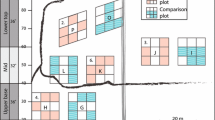Abstract
This paper examines the maple syrup production potential of American forests by analyzing Forest Inventory & Analysis (FIA) data provided by the US Forest Service on the resource of sugar maple (Acer saccharum Marsh.) and red maple (Acer rubrum L.) trees in twenty states. The analysis is based on tree species and size (diameter at breast height, or dbh), ownership category, jurisdiction, the density of maple trees in a stand, and the distance of the stand to an access road. Although there are over 2 billion sugar and red maple trees of tappable size growing in US forests, when narrowed down according to the attributes of an optimal ‘sugarbush’, there are 100 million potential taps from sugar maples alone and 286 million potential taps with sugar and red maples combined. Overall, 45 % of the tappable-size maple trees are found in stands whose density is not high enough to support commercial sap extraction whereas only 6 % are found in stands that are at least 1.6 km from an access road. The ten states with commercial maple syrup industries have a much higher percentage of their maple trees occurring in stands of optimal density and also contain a higher percentage of sugar maple than red maple trees. States that are utilizing the highest percentage of their potential sugarbushes include Vermont and Maine, whereas states that have significant room for expansion include Michigan, New York, and Pennsylvania.



Similar content being viewed by others
References
Bechtold W, Patterson P (2005) The enhanced forest inventory and analysis program: National sampling design and estimation procedures. General Technical Report SRS-80, NC: US Department of Agriculture Forest Service, Southern Research Station, Asheville
Buchheit J, Carver A, Zaczek J, Crum M, Mangun J, Williard K, Preece J (2004) Economic feasibility of commercial maple syrup production in Illinois. Proceedings of the 14th Central Hardwood Forest Conference. Newtown Square, PA, GTR-NE-316
Census Office US (1860) Statistics of agriculture, eighth census. Government Printing Office, Washington DC
Collins E (2001) Estimating a non-timber forest resource–maple syrup-using forest inventory and analysis data. Proceedings Soc Am Foresters 2000 Nat Convention SAF, Bethesda, pp 276–287
Dravis S (2008) Shortfall drives prices higher. Maple News 7(5):1
Farrell M (2009), Assessing the growth potential and future outlook for the US maple syrup industry. In: Gold M, Hall MM (eds) Agroforestry comes of age: putting science into practice. Proceedings, 11th North American Agroforestry Conference, Columbia MO, May 31–June 3 2009 pp 99–106
Farrell M, Chabot B (2012) Assessing the growth potential and economic impact of the US maple syrup industry. J Agric Food Syst Community Develop 2(2):11–27. doi:10.5304/jafscd.2012.022.009
Farrell M, Stedman R (2011) Assessing the growth potential of the northern forest maple industry: a survey of landowners http://maple.dnr.cornell.edu/NSRC%20landowner%20survey%20report.pdf. Accessed 22 Jan 2012
Fei S, Steiner K (2007) Evidence for increasing red maple abundance in the Eastern United States. Forest Sci. 53:473–477
Heiligmann R, Koelling M, Perkins T (2006) North American maple syrup producers manual, 2nd edn. The Ohio State Univ, Columbus
Hill D (2010) Forest farming: Have maples, will sugar. University of Kentucky Cooperative Extension Service publication FOR-118 http://www.ca.uky.edu/forestryextension/Publications/Hill/FOR118.pdf. Accessed 22 Jan 2012
Hinrichs C (1998) Sideline and lifeline: the cultural economy of maple syrup production. Rural Sociol 63:507–532
MRN-MAPAQ Rapport (2000) Contribution du territoire public quebecois au developpement de l’acericulture. Ministère des Resources naturelles et Ministère de l’Agriculture, des Pêcheries et de l’Alimentation
Nearing H, Nearing S (2000) The maple sugar book: together with pioneering as a way of life in the twentieth century. Chelsea Green Publishing, White River Junction
Skinner C, DeGaetano A, Chabot B (2010) Implications of twenty-first century climate change on Northeastern United States maple syrup production: impacts and adaptations. Climatic Change 100:685–702
Statistics Canada (2011, Dec. 14) Table 001–0008—Production and farm value of maple products, annual (table). CANSIM (database). Retrieved from http://www.statcan.gc.ca/cansim/a26?lang=eng&retrLang=eng&id=0010008&pattern=maple&tabMode=dataTable&srchLan=-1&p1=1&p2=-1
Taylor R (1965) Characteristics of the United States producer maple syrup markets: a thesis in agricultural economics. PhD Dissertation, Pennsylvania State University
US Department of Agriculture, Economic Research Service (2011) Table 43—US maple syrup production, imports, exports, and prices, by calendar year [Excel spreadsheet]. Retrieved from http://www.ers.usda.gov/briefing/sugar/data/table 43.xls
Whitney G, Upmeyer M (2004) Sweet trees, sour circumstances: The long search for sustainability in the North American maple products industry. For Ecol Manage 200:313–333
Wilmot T (2011) High vacuum without a pump. Farming: J Northeast Agric. http://www.farmingmagazine.com/article-7484.aspx. Accessed 26 Jan 2012
Acknowledgments
Special thanks to Brian Chabot and anonymous reviewers for providing helpful feedback on this document, Charles Barnett and Richard McCullough of the US Forest Service for providing the necessary FIA data, all of the FIA field crews that collected the data, and to the Northeastern States Research Council for providing partial funding for this research.
Author information
Authors and Affiliations
Corresponding author
Rights and permissions
About this article
Cite this article
Farrell, M. Estimating the maple syrup production potential of American forests: an enhanced estimate that accounts for density and accessibility of tappable maple trees. Agroforest Syst 87, 631–641 (2013). https://doi.org/10.1007/s10457-012-9584-7
Received:
Accepted:
Published:
Issue Date:
DOI: https://doi.org/10.1007/s10457-012-9584-7




